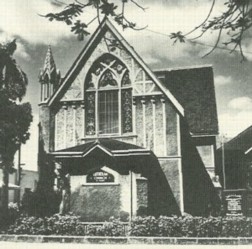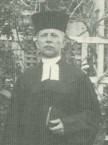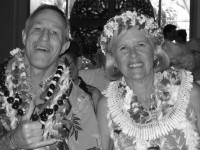On September 9, 2000, the Lutheran Church of Honolulu celebrated its 100th anniversary with worship, music, skits, and feasting. The ministry of LCH had spanned the 20th century, closely entwined with the history of Hawai‘i and the nation. Nourished and shaped by this history, the congregation looks forward to continuing its witness and service into the future. LCH has evolved through several different eras.
1900 to 1917: The German Years
The Hackfelds and the Isenbergs, two German families that arrived in the Kingdom of Hawai‘i in the mid-1800s, were instrumental in founding and funding the church. Merchant Heinrich Hackfeld began the firm later known as American Factors Ltd. or Amfac, and Paul Isenberg was a businessman and sugar plantation owner. In the late 1800s, Amfac brought 1,500 contract workers and their families from Germany to work on its plantations.

The original church building on Beretania.
On September 9, 1900, the Territorial Government approved the Charter of the Deutsch-Evangelisch-Lutherische Gemeinde zu Honolulu. The Hackfelds and Isenbergs each donated $25,000 to build a church and import a pastor and pipe organ from Germany. Such generous donations by the founders, their relatives, and friends meant plate offerings were unnecessary during the early years.
When the United States entered World War I in April 1917, everything changed. Ties with the State Church of Germany lapsed. By 1919, Germans and German-Americans lost their positions at Amfac and the firm’s assets were seized. Although this sharply reduced financial support for the church, contributions from early German parishioners continued for another 40 years.
1916 to 1946: The Hörmann Years

The Rev. Dr. Arthur Hörmann
In the summer of 1916, the Rev. Dr. Arthur Hörmann, an American citizen educated in Germany, arrived to pastor the church. Under Dr. Hörmann’s guidance, LCH changed from a German-speaking, foreign-based congregation to an American church. English services were introduced gradually, and both languages were used in the ministry until 1941, when the U.S. entered World War II and the church legally became “The Lutheran Church of Honolulu.” Pastor Hörmann expanded membership beyond the German-American community and asked all parishioners to commit their time, talent, and financial support. He also encouraged LCH to affiliate with the United Lutheran Church in America, which became the Evangelical Lutheran Church in America after several mergers. LCH became part of the ELCA in 1991.
1947 to 2000: Post-War and the Johnson Years

Dedication of the current church building in 1953.
In the late 1940s following World War II, the Territory of Hawai‘i acquired the church’s first home on Beretania Street in what is now the Hawai‘i Capitol District. LCH bought its present site on Punahou Street in Manoa in 1952 and dedicated a new sanctuary and parish hall on October 4, 1953.
By 1970, the density of the neighborhood had increased, and the open architectural style no longer offered a quiet place for worship. Under the Rev. Dr. Donald K. Johnson, who became pastor in 1969, the church began planning for a major renovation. Respected local architect Vladimir Ossipoff relocated the altar to the middle of the nave and enclosed the worship space, enhancing the participation of the congregation in the Word and Sacrament and bringing the Eucharist into the midst of the people. Ossipoff’s design also made the Hörmann Courtyard a gathering place for families, friends and visitors. The new nave was dedicated in 1975.
Music has always been central to the worship life at LCH. Accordingly, the renovation included a new tracker organ by Rudolph von Beckerath of Hamburg, Germany. Cantor (music director) Carl Crosier has built a stellar music program for Sunday worship, special concerts, and recitals around the organ. Organist Katherine Crosier and technicians from von Beckerath have carefully maintained the instrument. LCH presentations of numerous works of J.S. Bach, most notably the performances to sold-out audiences of the St. Matthew Passion in March 2000, continue to reflect the congregation’s German heritage.

The Rev. Dr. Don Johnson and his wife Ruth at his retirement luau.
In an effort to model the healing love of Christ, church members voted overwhelmingly to become a Reconciling in Christ congregation in 1993. Since then, the church has received gay and lesbian persons, extending to them all rights, privileges, and responsibilities of membership. Our growing diversity has challenged us and immeasurably enriched our corporate life as people of God. LCH also led the Pacifica Synod to become a Reconciling in Christ Synod within the ELCA.
In 1998 the congregation voted to assume direction of the preschool, which had been operated by an outside service provider for many years. LCH subsidized the facility financially, and church members served on the board of directors. In early 2006, responding to overtures from Our Redeemer Lutheran Church and School (Missouri Synod) as well as illness on the part of the preschool director, management of the preschool was transferred to Our Redeemer. The school continues with a year-round enrollment of over 50 children, ages 2–5.
2000 to 2007: The Barber Years and a Brief Interim
Following Pastor Johnson’s retirement in early 2000, the Rev. David J. Barber was called as intentional interim pastor. Pastor Barber arrive towards the beginning of Lent, just a month before the St. Matthew extravaganza, and soon realized (as he said in his Easter sermon that year) that there is something a little “insane” about LCH. Over the next year, which included the 100th anniversary of the founding of the congregation, the match between Pastor Barber and LCH became apparent to many. Even though normal procedures do not allow a congregation to call their interim as pastor, Pacifica Bishop Murray Finck granted an exception, and the congregation joyously installed Pastor Barber on September 9, 2001.

Pastor David and Karen Barber at their farewell celebration
The tragic events of September 11, 2001, could not quelled our momentum to move forward. The congregation approved a new mission statement in June 2002 and launched new initiatives in youth and family ministry, outreach, and communication. In the fall of 2003, the congregation undertook a three-year Capital Funds Campaign (2004–2006) for improvements to the LCH campus. This campaign was planned as the first phase of a long-term project to ensure that our facilities can support the congregation’s mission. The congregation has also hosted two seminary interns: Katy Grindberg (Pacific Lutheran Theological Seminary, 2004–2005) and Joshua Graber (Luther Seminary, 2005–2006).
Following Pastor Barber’s retirement in May 2006, LCH again entered an interim period. Under Interim Pastor Steven Jensen, the Ministry Planning Task Force and the Call Committee led the congregation to clarify goals for future ministry and began the search process. At the same time, through extensive congregational involvement in demolition and various phases of the construction, the kitchen and the restroom were completely gutted and remodeled, bringing the three-year Capital Campaign to a successful conclusion.
2007–2024: The Lilley Years
LCH called the Rev. Jeff Lilley as the twelfth called pastor of the Lutheran Church of Honolulu, and he was installed on May 20, 2007. Over the years, Pastor Jeff challenged the people of LCH to be actively involved in the mission of God, who is at work in the world.
Responding to this call, the congregation voted in May 2011 to begin a fundraising campaign designed to provide staff and physical resources that would enable us to fulfill the congregation’s mission planning efforts. These goals included the covering of the Hörmann Courtyard to support additional ministries, and a complete renovation of the parking lot behind the church. A third goal was achieved with the calling of Angela Freeman as associate pastor. From August 2012 through January 2015, Pr. Freeman shared the full range of pastoral duties with Pr. Lilley as part of a comprehensive ministry team.
Pr. Jeff’s time saw significant transition in the music ministry of LCH. The announcement of Carl Crosier’s retirement as cantor, effective in August 2011, kicked off “another year of insanity” in the LCH music program. That season included the Monteverdi Vespers, Bach’s Mass in B-Minor, five Bach cantatas, Vivaldi’s Four Seasons, and Haydn’s Lord Nelson Mass. Carl’s 38-year ministry was celebrated at his final worship service on August 21, 2011. Dr. Miguel Felipe, director of choral Activities at the University of Hawaii at Mānoa, assumed the music ministry of LCH as director of music and liturgy and served from August 2011 through Advent 2014, when he left LCH to focus more fully on his obligations to the University of Hawai‘i Music Department. Jeremy Wong, a long-time member of the choir, served as interim until the call of Scott Fikse in the summer of 2015. Scott’s leadership strengthened the LCH music in many areas. The Early Worship Ensemble formed to lead the 8:00 am service, and Compline services were restored twice monthly led by the Men’s Schola. Scott also began the successful First Monday’s Concert Series (September through May) and Summer Jazz (June through August). Scott left LCH in the summer of 2022 to pursue graduate studies in the Pacific Northwest. He was succeeded by Dr. Barry Wenger as both director of music and liturgy and organist in November of that year. Barry has built on and added to the rich history of music at LCH. He is currently overseeing the renovations of the Beckerath organ and, working with the property committee, the construction of a new choir loft that provides both a more stable platform and better sightlines for our singers.
In the spring of 2018, the congregation purchased new pew chairs to replace the 70-year old mahogany pews. The old pews did not go to waste. Some were sold to local woodworkers, and others were used at the church. Pr. Jeff constructed the Aloha Cart with some of the wood, and he and Rich Mundell used others in building the new stairway to the loft above the Boardroom.
Later that summer, the congregation welcomed Andy Flatt-Kuntze (along with his husband Justin) as seminary intern pastor for one year. The internship proved beneficial to both the congregation and the intern, and the decision was made to host an intern every other year.
The covid-19 pandemic led the congregation to switch to online worship in the spring of 2020 and transition most educational and small-group activities to online meetings. In September, Brianna (Bree) Lloyd arrived as our new intern pastor. Following the completion her intern year, Bree was called as associate pastor and ordained in a festive service at LCH. She has since been called as pastor of Ka Hana O Ke Akua UCC in Wai‘anae.
With the advent of vaccines and the easing of the covid pandemic, LCH returned to in-person worship while maintaining streaming worship. This has revived the activity of the congregation. Following his sabbatical in the last quarter of 2023, and in anticipation of the congregation’s 125th anniversary in 2025, Pr. Jeff challenged the congregation to raise a total of $125,000 to fund a $65,000 renovation of the Beckerath organ and $60,000 to support the mission of the church. The congregation held a series of ‘ohana gatherings in the summer of 2024 to determine three priorities for the 125th Anniversary Mission Fund: a welcoming and safe environment; liturgy, music, and the arts; and preparing for the approaching silver tsunami.
The Present
Pr. Jeff Lilley passed suddenly just prior to worship on the morning of October 13, 2024. The congregation rallied to support each other and particularly to support Jeff’s widow Jean and their children. A memorial service was held on October 26, followed by the JeffFest in his honor. Pr. Margrethe Kleiber, who was ordained from LCH and served as interim pastor during Jeff’s sabbatical, agreed to serve as bridge pastor until an interim pastor could be found.
Pr. Lesley Radius joined LCH as or interim pastor on March 1, 2025. She will lead us through this period of discernment and prayer as we continue to live into God’s preferred and promised future.
The Future
The Lutheran Church of Honolulu is a dynamic Christian community. While shaped by history and grounded in tradition, LCH seeks pastoral and theological growth. We desire to deepen our faith, expand our understanding, and contribute to the healing of our broken world through worship, music, child and youth programs, adult education, and ministering to the hungry, the homeless, and people with HIV/AIDS. Wherever you are on your journey of faith, we invite you to join us.
March 2025
A history of the Lutheran Church of Honolulu, For Beer and the Bible, by Sandra Wagner-Wright, professor of history at University of Hawai‘i Hilo, was commissioned for the church’s centennial in 2000 and is available for $15.00. Please contact the church office at 808-941-2566 to order this book.

